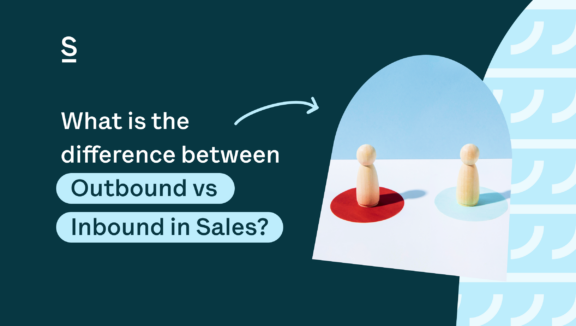Outbound vs Inbound in Sales: What is the difference?

Outbound vs Inbound sales are often easily confused by those newer to sales. Nonetheless, understanding the nuances of outbound vs inbound sales strategies is essential. Outbound sales, traditionally seen as the more proactive approach, involves reaching out to potential customers. In contrast, inbound sales focus on attracting customers through various channels.
The distinctions between these two strategies significantly impact how sales teams operate, target audiences, and achieve their goals. Grasping the essence of both approaches is crucial for sales professionals looking to refine their tactics and optimize their overall sales strategy.
Key Highlights
- Outbound sales strategies are proactive and involve direct outreach to potential customers, whereas inbound sales attract customers through various channels.
- Sales automation significantly enhances the efficiency of B2B outbound sales, streamlining sales outreach and follow-up processes.
- Integrating outbound and inbound sales strategies leads to a more seamless and effective sales process, improving lead qualification and customer experience.

Level up your outbound with Surfe
What is outbound in Sales?
Outbound sales are the backbone of traditional sales strategies. This approach is defined by its proactive nature, where sales teams initiate contact with potential customers. Think about outbound as messages that you are sending out. Key characteristics of outbound sales include direct sales outreach methods like cold calling, emailing, and face-to-face meetings. These tactics allow sales professionals to personally engage with prospects, establish trust, and guide them towards conversion.
Cold emailing, messages, and calling are particularly important in outbound sales. They are a key way to approach new leads and the personal touch they provide can be crucial in establishing trust with potential clients. A well-crafted cold call or email can stand out, showcasing a salesperson’s dedication and understanding of the prospect’s needs.
Outbound sales often involves using tools for tracking relationships (with CRMs such as HubSpot, Pipedrive, and Salesforce) and automating outreach (like Lemlist).
- Outbound sales primarily involve a proactive approach where sales representatives initiate contact with potential customers.
- In outbound sales, sales teams carefully select their target audience based on various criteria such as market research, customer profiles, and specific demographic or firmographic data.
- Success in outbound sales is heavily dependent on the sales representative’s skills, including their ability to persuade, negotiate, and handle objections.
What is inbound in sales?
Inbound sales revolve around customer-initiated actions. This strategy leverages various channels like company websites, blogs, social media, and content marketing to draw prospects towards the company. In contrast to the direct approach of outbound sales, inbound sales focus on attracting customers by providing value through information, solutions, and sales insights.
Content marketing plays a pivotal role in inbound sales. By creating and sharing valuable content, companies can expose potential buyers to their brand, build trust, and position themselves as thought leaders in their industry. This content-driven approach is not just about attracting leads; it’s about nurturing them through the sales funnel by providing relevant and helpful information.
- In inbound sales, the interaction is initiated by the customer, not the sales team. Potential customers reach out after finding the company through channels like websites, blogs, social media, or search engine results.
- Inbound sales involve nurturing leads at different stages of the buyer’s journey. From awareness to consideration and decision-making, each phase requires tailored communication and content to guide prospects towards a purchase.
- Inbound sales strategies often utilize various technologies to help in managing leads, personalizing customer interactions, tracking engagement, and analyzing results for continuous improvement.
Outbound vs Inbound: A Comparative Analysis
Outbound vs inbound sales approaches differ significantly in their strategies, target audiences, and execution. Outbound sales are proactive and often target specific customer segments through personalized communication. This approach requires a deep understanding of the customer’s needs and a strategic approach to outreach. In contrast, inbound sales attract a broader audience through content and digital presence, focusing on attracting leads to the company.
Each method has its challenges and advantages. Outbound sales can be more time-consuming and often have lower response rates. However, when executed well, they can establish strong personal connections and trust. Inbound sales, while cost-effective and scalable, can struggle to stand out in a crowded digital space.
Top differences between Outbound vs Inbound sales
- Outbound sales involve proactive contact initiated by sales teams, while inbound sales are driven by customers seeking out the company through online content and marketing channels.
- In outbound sales, interactions are typically transactional and based on scripted pitches, while inbound sales foster more organic, relationship-oriented communications.
- Outbound sales success is measured through direct sales metrics like call volume and conversion rates, whereas inbound sales track engagement and lead quality through digital analytics.

Connect your CRM to LinkedIn with Surfe
Surfe bridges the gap between LinkedIn and HubSpot, Pipedrive, Salesforce, Copper, or Google Sheets.
The Synergy of using Outbound and Inbound Sales together
Combining outbound and inbound sales strategies can create a more cohesive and effective sales process. This integrated approach leverages the strengths of both methods, resulting in increased efficiency, better lead qualification, and improved customer experience.
A seamless sales process benefits from the proactive outreach of outbound strategies and the wide reach of inbound methods. This synergy ensures that prospects are engaged at every stage of their journey, from initial awareness to decision-making. It also helps in maintaining a consistent brand message across different channels and touchpoints.
Best practices in sales pipeline management often involve a blend of outbound vs inbound tactics. For instance, initial outreach through outbound methods can be followed up with inbound content marketing to nurture leads. Similarly, leads generated through inbound channels can be further engaged with personalized outbound communication. This approach ensures a comprehensive coverage of the sales funnel, maximizing the chances of conversion.
Let’s wrap it up!
The differences between outbound vs inbound sales are significant, yet their integration can lead to a powerful synergy. Understanding and effectively implementing both strategies is key to maximizing sales performance. Sales teams should strive for a balanced approach, leveraging the direct engagement of outbound sales and the wide-reaching attraction of inbound sales. This combined strategy enhances lead generation, customer engagement, and overall sales success, making it an essential practice for modern sales teams looking to excel in a competitive marketplace.


